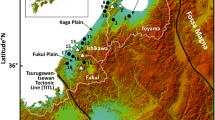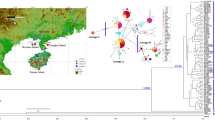Abstract
Since mitochondrial DNA (mtDNA) are maternally inherited without recombination, geographic distribution of mtDNA in semiterrestrial cercopithecines is considered to be influenced by female philopatry. I examined the effect of sex difference in migration patterns on geographic distribution in a habitat whose environment has changed frequently. I investigated ten groups (n = 77) of grivets (Cercopithecus aethiops aethiops) along a 600-km stretch of the Awash River, Ethiopia. I examined the mtDNA distribution among natural local populations whose nuclear variation was already shown to have a widely homogeneous distribution. RFLP analysis of whole mtDNA genome using 17 enzymes identified ten haplotypes in five clusters (haplogroups). Sequence divergence within haplogroups ranged from 0.17%–0.38%, while divergence between haplogroups ranged between 1.0%–2.5%. Haplogroups were distributed in blocks which ranged from 120–250 km along the Awash River. The haplotype distribution pattern of males indicated that they migrate between the boundaries of these blocks. Moreover, a clumped distribution pattern suggests the history of matrilineal distribution by group fission and geographic expansion.
Similar content being viewed by others
REFERENCES
Avise, J. C. (1994). Molecular Markers, Natural History, and Evolution, Chapman and Hall, New York.
Avise, J. C., Arnold, J., Ball, R. M., Bermingham, E., Lamb, T., Neigel, J. E., Reeb, C. A., and Sauders, N. C. (1987). Intraspecific phylogeography: The mitochondrial DNA bridge between population genetics and systematics. Ann. Rev. Ecol. Syst. 18: 489-522.
Avise, J. C., Joseph, E. N., and Arnold, J. (1984). Demographic influences on mitochondrial DNA lineage survivorship in animal populations. J. Mol. Evol. 20: 99-105.
Cheney, D. L., and Seyfarth, R. M. (1983). Nonrandom dispersal in free-ranging vervet monkeys: Social and genetic consequences. Am. Nat. 122: 392-412.
DeBry, R. W., and Slade, N. A. (1985). Cladistic analysis of restriction endonuclease cleavage maps within a maximum-likelihood framework. Syst. Zool., 34: 21-34.
Dowling, T. F., Moritz, C., and Palmer, J. D. (1990). Nucleic acids. II. restriction site analysis. In Hillis, D. M., and Moritz, C. (eds.), Molecular Systematics, Sinauer, Sunderland, pp. 250-317.
Gasse, F. A., Rognon, R., and Street, F. A. (1980). Quaternary history of the Afar and Ethiopian Rift lakes. In Williams, M. A. J., and Faure, H. (eds.), The Sahara and the Nile, A. A. Balkema, Rotterdam, pp. 361-400.
Gasse, F. A., and Street, F. A. (1978). Late Quaternary lake-level fluctuations and environments of the Northern Rift Valley and Afar Region (Ethiopia and Djibouti). Palaeogeog. Palaeoclimatol. Palaeoecol. 24: 279-325.
Grove, A. T., Street, F. A., and Goudie, A. S. (1975). Former lake levels and climatic change in the rift valley of southern Ethiopia. Geogrl. J. 141: 177-202.
Hamilton, A. C. (1982). Environmental History of East Africa: A Study of the Quaternary, Academic Press, London.
Hamilton, A. C. (1988). Guenon evolution and forest history. In Gautier-Hion, A., Bourliére, F., Gautier, J-P., and Kingdon, J. (eds.), A Primate Radiation: Evolutionary Biology of the African Guenons, Cambridge University Press, New York, pp. 13-34.
Harihara, S., Saitou, N., Hirai, M., Aoto, N., Terao, K., Cho, F., Honjo, S., and Omoto, K. (1988). Differentiation of mitochondrial DNA types in Macaca fascicularis. Primates 29: 117-127.
Hayasaka, K., Horai, S., Shotake, T., Nozawa, K., and Matsunaga, E. (1986). Mitochondrial DNA polymorphism in Japanese monkeys, Macaca fuscata. Jap. J. Genet. 61: 345-359.
Hoelzer, G. A., Dittus, W. P. J., Ashley, M. V., and Melnick, D. J. (1994). The local distribution of highly divergent mitochondrial DNA haplotypes in toque macaques Macaca sinica at Polonnaruwa, Sri Lanka. Mol. Ecol. 3: 451-458.
Kawamoto, Y., Ishida, T., Suzuki, J., Takenaka, O., and Varavudhi, P. (1989). A preliminary report on the genetic variations of crab-eating macaques in Thailand. Kyoto University Overseas Research Report of Studies on Asian Nonhuman Primates. (1988). 7: 94-103. Kyoto University Primate Research Institute.
Kawamoto, Y., Ischak, T. M., and Supritna, J. (1984). Genetic variations within and between troops of the crab-eating macaque (Macaca fascicularis) on Sumatra, Java, Bali, Lombok, and Sumbawa, Indonesia. Primates 25: 131-159.
Melnick, D. J., and Hoelzer, G. A. (1992). Differences in male and female macaque dispersal lead to contrasting distributions of nuclear and mitochondrial DNA variation. Int. J. Primatol. 13: 379-393.
Melnick, D. J., and Hoelzer, G. A. (1993). What is mtDNA good for in the study of primate evolution? Evol. Anthropol. 2: 2-10.
Melnick, D. J., and Hoelzer, G. A. (1996). The population genetic consequences of macaque social organisation and behaviour. In Fa, J. E., and Lindburg, D. (eds.), Evolution and Ecology of Macaque Societies. Cambridge University Press, New York, pp. 413-443.
Melnick, D. A., Hoelzer, G. A., Absher, R., and Ashley, M. V. (1993). mtDNA diversity in rhesus monkeys reveals overestimates of divergence time and paraphyly with neighboring species. Mol. Biol. Evol. 10: 282-295.
Moore, J. (1984). Female transfer in primates. Int. J. Primatol. 5: 537-589.
Nei, M. (1987). Molecular Evolutionary Genetics, Columbia University Press, New York.
Nei, M., and Tajima, F. (1983). Maximum likelihood estimation of the number of nucleotide substitutions from restriction site data. Genetics 105: 207-217.
Neigel, J. E., and Avise, J. C. (1986). Phylogenetic relationships of mitochondrial DNA under various demographic models of speciation. In Karlin, S., and Nevo, E. (eds.), Evolutionary Process and Theory, Academic Press, New York, pp. 515-534.
Nozawa, K., Shotake, T., Minezawa, M., Kawamoto, Y., Hayasaka, K., Kawamoto, S., and Ito, S. (1991). Population genetics of Japanese monkeys: III. Ancestry and differentiation of local populations. Primates 32: 411-435.
Ota, T. (1994). RESTDATA: Restriction Data and Phylogenetic Analysis, Institute of Molecular Evolutionary Genetics, The Pennsylvania State University, University Park, PA.
Pusey, A. E., and Packer, C. (1987). Dispersal and philopatry. In Smuts, B. B., Cheney, D. L., Seyfarth, R. M., Wrangham, R. W., and Struhsaker, T. T. (eds.), Primate Societies, University of Chicago Press, Chicago, pp. 250-266.
Rosenblum, L. L., Supriatna, J., and Melnick, D. J. (1997). Phylogeographic analysis of pigtail macaque populations (Macaca nemestrina) inferred from mitochondrial DNA. Amer. J. Phys. Anthropol. 104: 35-45.
Saitou, N., and Nei, M. (1987). The neighbor-joining method:Anew method for reconstructing phylogenetic trees. Mol. Biol. Evol. 4: 406-425.
Shimada, M. K., and Shotake, T. (1997). Genetic variation of blood proteins within and between local populations of grivet monkey (Cercopithecus aethiops aethiops) in central Ethiopia. Primates 38: 399-414.
Shotake, T., Nozawa, K., and Santiapilai, C. (1991). Genetic variability within and between the troops of toque macaque, Macaca sinica, in Sri Lanka. Primates 32: 283-299.
Southern, E. M. (1975). Detection of specific sequences among DNA fragments separated by gel electrophoresis. J. Mol. Biol. 98: 503-517.
Swofford, D. L. (1993). PAUP: Phylogenetic Analysis Using Parsimony, Version 3.1.1, Computer program, Smithsonian Institution, Washington, DC.
Swofford, D. L., and Olsen, G. J. (1990). Phylogeny reconstruction. In Hillis, D. M., and Moritz, C. (eds.), Molecular Systematics, Sinauer, Sunderland, pp. 411-501.
Takenaka, O., Takenaka, A., Arakawa, M., Ishida, T., Suzuki, J., Kawamoto, Y., and Varavudhi, P. (1989). The multiple a-globin genes in the crab-eating macaques (Macaca fascicularis) and geographic distribution in Thailand. Kyoto University Overseas Research Report of Studies on Asian Nonhuman Primates. (1988) 7: 94-103. Kyoto Univ. Primate Res. Institute.
Templeton, A. R. (1983). Phylogenetic inference from restriction endonuclease cleavage site maps with particular reference to the evolution of humans and the apes. Evolution 37: 221-244.
Author information
Authors and Affiliations
Rights and permissions
About this article
Cite this article
Shimada, M.K. Geographic Distribution of Mitochondrial DNA Variations among Grivet (Cercopithecus aethiops aethiops) Populations in Central Ethiopia. International Journal of Primatology 21, 113–129 (2000). https://doi.org/10.1023/A:1005479714606
Issue Date:
DOI: https://doi.org/10.1023/A:1005479714606




